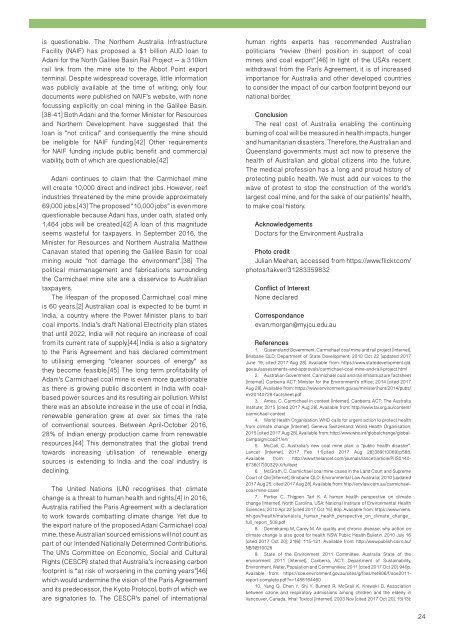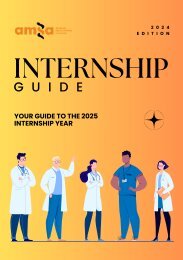Vector Volume 11 Issue 2 - 2017
You also want an ePaper? Increase the reach of your titles
YUMPU automatically turns print PDFs into web optimized ePapers that Google loves.
is questionable. The Northern Australia Infrastructure<br />
Facility (NAIF) has proposed a $1 billion AUD loan to<br />
Adani for the North Galilee Basin Rail Project – a 310km<br />
rail link from the mine site to the Abbot Point export<br />
terminal. Despite widespread coverage, little information<br />
was publicly available at the time of writing; only four<br />
documents were published on NAIF’s website, with none<br />
focussing explicitly on coal mining in the Galilee Basin.<br />
[38-41] Both Adani and the former Minister for Resources<br />
and Northern Development have suggested that the<br />
loan is “not critical” and consequently the mine should<br />
be ineligible for NAIF funding.[42] Other requirements<br />
for NAIF funding include public benefit and commercial<br />
viability, both of which are questionable.[42]<br />
Adani continues to claim that the Carmichael mine<br />
will create 10,000 direct and indirect jobs. However, reef<br />
industries threatened by the mine provide approximately<br />
69,000 jobs.[43] The proposed “10,000 jobs” is even more<br />
questionable because Adani has, under oath, stated only<br />
1,464 jobs will be created.[42] A loan of this magnitude<br />
seems wasteful for taxpayers. In September 2016, the<br />
Minister for Resources and Northern Australia Matthew<br />
Canavan stated that opening the Galilee Basin for coal<br />
mining would “not damage the environment”.[38] The<br />
political mismanagement and fabrications surrounding<br />
the Carmichael mine site are a disservice to Australian<br />
taxpayers.<br />
The lifespan of the proposed Carmichael coal mine<br />
is 60 years.[2] Australian coal is expected to be burnt in<br />
India, a country where the Power Minister plans to ban<br />
coal imports. India’s draft National Electricity plan states<br />
that until 2022, India will not require an increase of coal<br />
from its current rate of supply.[44] India is also a signatory<br />
to the Paris Agreement and has declared commitment<br />
to utilising emerging “cleaner sources of energy” as<br />
they become feasible.[45] The long term profitability of<br />
Adani’s Carmichael coal mine is even more questionable<br />
as there is growing public discontent in India with coalbased<br />
power sources and its resulting air pollution. Whilst<br />
there was an absolute increase in the use of coal in India,<br />
renewable generation grew at over six times the rate<br />
of conventional sources. Between April-October 2016,<br />
28% of Indian energy production came from renewable<br />
resources.[44] This demonstrates that the global trend<br />
towards increasing utilisation of renewable energy<br />
sources is extending to India and the coal industry is<br />
declining.<br />
The United Nations (UN) recognises that climate<br />
change is a threat to human health and rights.[4] In 2016,<br />
Australia ratified the Paris Agreement with a declaration<br />
to work towards combatting climate change. Yet due to<br />
the export nature of the proposed Adani Carmichael coal<br />
mine, these Australian sourced emissions will not count as<br />
part of our Intended Nationally Determined Contributions.<br />
The UN’s Committee on Economic, Social and Cultural<br />
Rights (CESCR) stated that Australia’s increasing carbon<br />
footprint is “at risk of worsening in the coming years”[46]<br />
which would undermine the vision of the Paris Agreement<br />
and its predecessor, the Kyoto Protocol, both of which we<br />
are signatories to. The CESCR’s panel of international<br />
human rights experts has recommended Australian<br />
politicians “review (their) position in support of coal<br />
mines and coal export”.[46] In light of the USA’s recent<br />
withdrawal from the Paris Agreement, it is of increased<br />
importance for Australia and other developed countries<br />
to consider the impact of our carbon footprint beyond our<br />
national border.<br />
Conclusion<br />
The real cost of Australia enabling the continuing<br />
burning of coal will be measured in health impacts, hunger<br />
and humanitarian disasters. Therefore, the Australian and<br />
Queensland governments must act now to preserve the<br />
health of Australian and global citizens into the future.<br />
The medical profession has a long and proud history of<br />
protecting public health. We must add our voices to the<br />
wave of protest to stop the construction of the world’s<br />
largest coal mine, and for the sake of our patients’ health,<br />
to make coal history.<br />
Acknowledgements<br />
Doctors for the Environment Australia<br />
Photo credit<br />
Julian Meehan, accessed from https://www.flickr.com/<br />
photos/takver/31283359832<br />
Conflict of Interest<br />
None declared<br />
Correspondance<br />
evan.morgan@my.jcu.edu.au<br />
References<br />
1. Queensland Government. Carmichael coal mine and rail project [Internet].<br />
Brisbane QLD: Department of State Development; 2010 Oct 22 [updated <strong>2017</strong><br />
June 19; cited <strong>2017</strong> Aug 28]. Available from: https://www.statedevelopment.qld.<br />
gov.au/assessments-and-approvals/carmichael-coal-mine-and-rail-project.html<br />
2. Australian Government. Carmichael coal and rail infrastructure factsheet<br />
[Internet]. Canberra ACT: Minister for the Environment’s office; 2014 [cited <strong>2017</strong><br />
Aug 28]. Available from: https://www.environment.gov.au/minister/hunt/2014/pubs/<br />
mr20140728-factsheet.pdf<br />
3. Amos, C. Carmichael in context [Internet]. Canberra ACT: The Australia<br />
Institute; 2015 [cited <strong>2017</strong> Aug 28]. Available from: http://www.tai.org.au/content/<br />
carmichael-context<br />
4. World Health Organisation. WHO calls for urgent action to protect health<br />
from climate change [Internet]. Geneva Switzerland: World Health Organisation;<br />
2015 [cited <strong>2017</strong> Aug 28]. Available from: http://www.who.int/globalchange/globalcampaign/cop21/en/<br />
5. McCall, C. Australia’s new coal mine plan: a “public health disaster”.<br />
Lancet [Internet]. <strong>2017</strong> Feb <strong>11</strong>[cited <strong>2017</strong> Aug 28];389(10069):p588.<br />
Available from: http://www.thelancet.com/journals/lancet/article/PIIS0140-<br />
6736(17)30329-X/fulltext<br />
6. McGrath, C. Carmichael coal mine cases in the Land Court and Supreme<br />
Court of Qld [Internet]. Brisbane QLD: Environmental Law Australia; 2010 [updated<br />
<strong>2017</strong> Aug 25; cited <strong>2017</strong> Aug 28]. Available from: http://envlaw.com.au/carmichaelcoal-mine-case/<br />
7. Portier C, Thigpen Tart K. A human health perspective on climate<br />
change [Internet]. North Carolina, USA: National Institute of Environmental Health<br />
Sciences; 2010 Apr 22 [cited <strong>2017</strong> Oct 15]. 80p. Available from: https://www.niehs.<br />
nih.gov/health/materials/a_human_health_perspective_on_climate_change_<br />
full_report_508.pdf<br />
8. Dennekamp M, Carey M. Air quality and chronic disease: why action on<br />
climate change is also good for health. NSW Public Health Bulletin. 2010 July 16<br />
[cited <strong>2017</strong> Oct 20]; 21(6): <strong>11</strong>5-121. Available from: http://www.publish.csiro.au/<br />
NB/NB10026<br />
9. State of the Environment 20<strong>11</strong> Committee. Australia State of the<br />
environment 20<strong>11</strong> [Internet]. Canberra, ACT: Department of Sustainability,<br />
Environment, Water, Population and Communities; 20<strong>11</strong> [cited <strong>2017</strong> Oct 20]. 940p.<br />
Available from: https://soe.environment.gov.au/sites/g/files/net806/f/soe20<strong>11</strong>-<br />
report-complete.pdf?v=1488164460<br />
10. Yang Q, Chen Y, Shi Y, Burnett R, McGrail K, Krewski D. Association<br />
between ozone and respiratory admissions among children and the elderly in<br />
Vancouver, Canada. Inhal Toxicol [Internet]. 2003 Nov [cited <strong>2017</strong> Oct 20]; 15(13):<br />
24

















